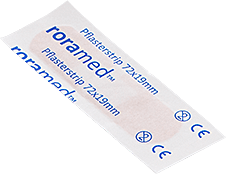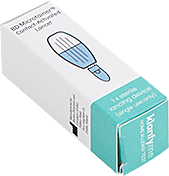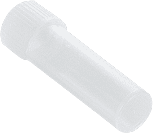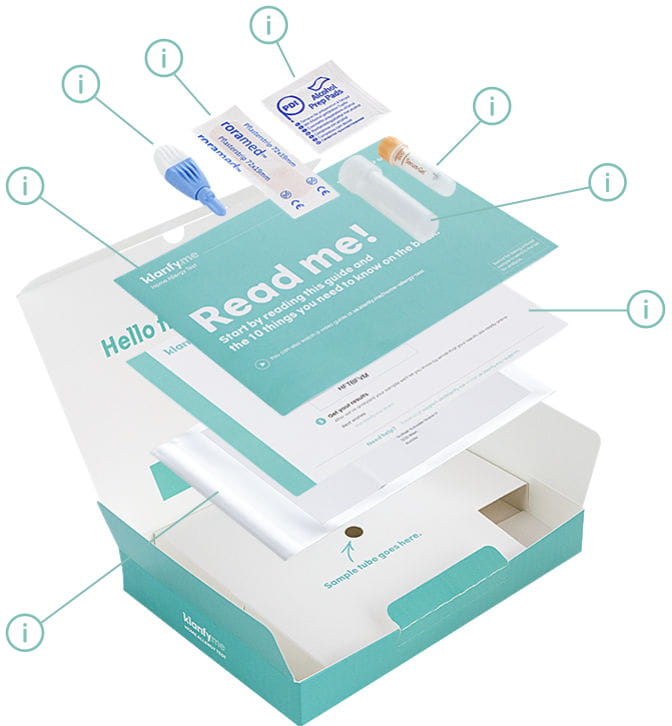Storage and dust mite allergy test
Do you find yourself wondering, “Do I have allergies?” Are you experiencing symptoms and suspect that mite might be the culprit? How do you know if mites are causing your allergy symptoms or something else?
Allergic reactions can be annoying and get in the way of everyday life. For some people, allergies can even be life-threatening. More than half the people with allergies are sensitised to more than one potential allergen. So, you may be allergic to more than just mites. When you can’t figure it out on your own, the Home Allergy Test may help.
The Home Allergy Test is a first step to finding out if mites might be causing your allergy symptoms. The allergy test kit is easy to use and super convenient as you can test for mite allergy at home.
About the storage and dust mite allergy test
The Home Allergy Test is a test kit based on sophisticated technology. It’s easy to use. It’s convenient too because you can use the storage and dust mite allergy test kit at home.
The storage and dust mite allergy test kit contains everything you need to collect a small blood sample from your fingertip. Allow about 30 minutes to collect your blood sample. There’s a step-by-step guide to help you and you can also watch our how-to video. We include a prepaid return envelope in the kit for you to pop your blood sample in the post to our partner lab for analysis. We need you to post the sample within 24 hours after collecting it to make sure it’s stable and suitable for testing.
You’ll need to activate your test online, which also creates your unique account if you don’t already have one with us. The test kit includes all the details you need to do this.
The antibody Immunoglobulin E (IgE) plays a vital role in allergic reactions to many allergens including house dust mite allergens and storage mite allergens. The Home Allergy Test can detect and identify the specific IgE antibodies in your blood, which can help pinpoint potential triggers of your allergy symptoms.
The comprehensive and reliable results of your storage and dust mite allergy test will be available in your online account within two weeks.
Order your Home Allergy Test today and take the first step to finding out if house dust mites or storage mites might be causing your symptoms of allergy.
Many allergens, one test
The Home Allergy Test is a home-to-lab allergy blood test kit which analyses your body’s reaction to 294 different allergens including:
- Pollen 59
- Pets 25
- Insect stings 10
- Moulds & yeasts 13
- Foods 154
- Other 14
Symptoms of dust mite allergy and storage mite allergy
Because dust mites and storage mites live in and around our homes, they can affect many people all year round.
Dust mite allergy and storage mite allergy can make you feel like you have hay fever or a very persistent cold when you breath in the allergens. This symptom of dust mite allergy and storage mite allergy is known as perennial allergic rhinitis. Perennial, because it happens all the time and not just at certain times of the year, like seasonal hay fever. Allergic rhinitis causes symptoms similar to a common cold. The difference is it’s triggered by an allergic reaction and a cold is caused by a virus.
Dust mite allergy and storage mite allergy can also cause eczema due to your body reacting to the mites’ allergens. Your skin may become itchy, dry and cracked.
10 dust mite allergy and storage mite symptoms checklist
- Congested, stuffy nose
- Runny nose
- Sneezing
- Itchy nose
- Post-nasal drip (the feeling of mucus moving down the back of your throat)
- Itchy, red, watery eyes
- Cough
- Tight chest or wheezing
- Sinus inflammation/pain
- Skin reactions, rashes, eczema
Dust mite allergy and storage mite allergy can involve any combination from the checklist above.
All you need is in the box
Prepaid return envelope
Use this to send your sample to the lab
Welcome card
Includes your unique activation code and instructions how to use it
Step-by-step guide
Start by reading this guide and the 10 things you need to know on the back
Lancing device
Sterile device to prick your fingertip to obtain a small blood sample
Plaster
To put on your fingertip after collecting the blood sample
Alcohol wipes
Use to sanitise your finger
Transport tube
Filled sample tube goes into the transport tube. Both tubes are then sealed into the prepaid return envelope for posting to the lab
Sample tube
Tube to collect about 6 drops of blood










Why you should get tested for dust mite allergy and storage mite allergy
It’s easier to know how to manage and treat your symptoms of allergy once you know what’s triggering them. But some of the symptoms from a reaction to one type of allergen are similar to those caused by another. How do you know what’s what? A storage and dust mite allergy test could be the solution.
A storage and dust mite allergy test kit may help you find out if house dust mite allergens or storage mite allergens could be triggering your symptoms. And to rule out others. It can show if your sensitised to storage or dust mite particles but that doesn’t mean you’re necessarily allergic to them. It’s important for your doctor to consider any allergy test results along with your medical history to make a diagnosis of allergy.
With a diagnosis of allergy, you’ll know precisely what your triggers are and then you can take steps to reduce your exposure to them. And you can discuss your treatment options with your doctor.
House dust mite allergy: one of the most common allergies
House dust mites thrive in humid places. They don’t like dry environments.
They can be found in all rooms in your home, especially in your bed and bedroom. They favour pillows, mattresses, carpets, upholstered furniture and even items such as soft toys. In the right conditions, they’ll stay put all year round. Keeping humidity levels in your house down to a steady 30% to 50% can help reduce the numbers. A dehumidifier may be useful for that.
They’re only about a quarter of a millimetre long, but if you’re allergic to dust mites, they can pack a real punch. Thankfully, they don’t bite. But proteins in their droppings and shed skin particles can trigger allergic reactions in some people. The particles of their waste are microscopic, measuring about the same as a grain of pollen.
It’s easy to disturb the particles in our homes, simply by turning your head on your pillow, walking across carpets or cuddling a soft toy. Any such activity can create a cloud of dust mite allergens, which are breathed in triggering the allergic reaction.
Storage mite allergy: more mites causing trouble
Storage mites can be found in barns, kitchens, cupboards and pantries. Great numbers of storage mites have been found in cellars and other home areas with high humidity, as well as in stored foods.
Storage mites can present an occupational hazard among farmers and other agricultural workers who handle mite-infested grains and other stored materials.
Contact with the mites in grains, dried fruits, flour and other stored products can cause skin rashes. Airborne mites and their allergens can cause allergic rhinitis and can irritate the eyes.
Allergies and the immune system
All allergies involve our immune system. Our immune system’s job is to prevent or limit infection from bacteria, viruses, fungi and parasites. But in allergy, it goes a bit haywire.
Allergies are an overreaction of your immune system in response to a substance that’s normally harmless. In an allergic reaction your immune system produces IgE antibodies specific to the allergen it’s trying to fight. The IgE antibodies signal other cells to release various chemicals, including histamine. And it’s these chemicals that cause the symptoms of allergy.
It’s unlikely you’d have a reaction to house dust mites or storage mites the first time you encounter them. Your body has to go through the process of sensitisation before you develop an allergy to any substance.
Sensitisation means your body has become sensitive to an allergen. It’s the first step of developing an allergy. It starts with your immune system registering the allergen and memorising its particular structure so it can produce specific IgE antibodies in defence. Sensitisation isn’t the same as allergy. It doesn’t always lead to symptoms but symptoms don’t develop without sensitisation.
The Home Allergy Test can identify your sensitisation to 294 allergen extracts and allergen components. Take a first step to finding out if a dust mite or storage mite allergy might be causing your symptoms. Order your Home Allergy Test today.
Others say
"Very clear instructions and the packaging is high quality. Looking forward to receiving the results." - Sara P
"I got the results and I have to say, I am very impressed.
I have only ever noticed suffering from sensitivity to cats, dust and a bit on grass before moving house at the end of Feb and I’ve always been able to control these reactions with off the shelf antihistamine, the test confirmed sensitivity to all of these.
Since moving I have suffered badly from a far more severe reaction to something unknown, I had assumed it was pollen from the symptoms as I am now surrounded by trees and flowering plants and there is a park behind the house, so plenty of grass too. My hope when taking the test was to find out if this new issue was a general sensitivity or if there was something specific in my new environment which was causing it. I am delighted that the test came back with such a strong positive on Ash tree pollen along with a moderate on Olive (which as I’m reading are in some way connected) while showing no sensitivity to other tree pollen types at all.
Having checked the pollen season for Ash trees it seems to coincide really well with when I had my symptoms, I.e. through March and April I was really bad but its clearing up now in May to the point that its negligible now. Looking around outside I think I’ve spotted the culprit at the back of my garden right next to where I’ve been sitting when outside!
I was sceptical about spending the money on this but at the time my symptoms were so harsh I think I’d have tried almost anything! I’m so glad that I did this now." - Rob S.
"Great product! For a while now, I have suspected that my son might have an allergy. I was leaning towards tree or grass pollen, but he didn’t really seem to be consistently bothered when being outside. I bought the home allergy test to understand what he was sensitised to. The guide that comes with the product, made it a simple exercise to complete the test. Drawing the blood took about 20 seconds, and there is really little hassle at all.
The report came back within a couple of weeks and showed high sensitisation to house dust mite. Didn’t think of that beforehand. So now we know where to focus and we have had dialogue with our doctor for next steps and proper treatment." - Morten S.

